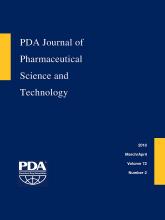Abstract
Aluminum-containing adjuvants have been widely used in vaccine formulations to safely and effectively potentiate the immune response. The examination of the extent of antigen adsorption to aluminum adjuvant is always evaluated during the development of aluminum adjuvant containing vaccines. A rapid, automated, high-throughput assay was developed to measure antigen adsorption in a 96-well plate format using a TECAN Freedom EVO® (TECAN). The antigen adsorption levels at a constant adjuvant concentration for each sample were accurately measured at 12 antigen/adjuvant (w/w) formulation ratios. These measurements were done at aluminum adjuvant concentrations similar to normal vaccine formulations, unlike previous non-automated and automated adjuvant adsorption studies. Two high-sensitivity analytical methods were used to detect the non-absorbed antigens. The antigen-to-adjuvant adsorption curves were fit to a simple Langmuir adsorption model for quantitatively analyzing the antigen to the adjuvant adsorption level and strength. The interaction of two model antigens, bovine serum albumin and lysozyme, with three types of aluminum adjuvant, were quantitatively analyzed in this report. Automated, high-throughput methodologies combined with sensitive analytical methods are useful for accelerating practical vaccine formulation development.
LAY ABSTRACT: Vaccines are probably the most effective public health method to prevent epidemics of many infectious diseases. Many of the most effective vaccines contain aluminum adjuvant. This report describes novel technology that can be used to better optimize the efficacy and stability of aluminum adjuvant–containing vaccines.
Abbreviations:
- AAHS
- amorphous aluminum hydroxyphosphate sulfate adjuvant
- Al
- elemental aluminum
- AlOH
- aluminum hydroxide adjuvant
- AP
- aluminum phosphate adjuvant
- BPP
- Biologics Pilot Plant
- BSA
- bovine serum albumin
- BSA-Alexa488
- bovine serum albumin labeled with Alexa488 fluorophore
- Dtap-IVP/Hib
- diphtheria, tetanus, cellular pertussis, inactivated polio virus, haemophilus influenza b vaccine
- CV%
- coefficient of variation %
- FDA
- Food and Drug Administration
- Hep A
- hepatitis A virus
- Hep B
- hepatitis B virus
- HPV
- human papilloma virus
- HT
- high-throughput
- LINEST
- Microsoft Excel® function that calculates the statistics of values fitting a line using the least squares method
- Lyso
- lysozyme
- Lyso-FITC
- lysozyme labeled with FITC fluorophore
- MMD
- Merck Manufacturing Division (West Point, PA)
- MW
- molecular weight
- P
- elemental phosphorous
- PCV13
- pneumo conjugate vaccine 13 serotype antigens
- pI
- protein isoelectric point
- PZC
- point of zero charge
- TECAN
- TECAN Freedom EVO® laboratory automation instrument
- VLP
- virus-like particle
- © PDA, Inc. 2018
PDA members receive access to all articles published in the current year and previous volume year. Institutional subscribers received access to all content. Log in below to receive access to this article if you are either of these.
If you are neither or you are a PDA member trying to access an article outside of your membership license, then you must purchase access to this article (below). If you do not have a username or password for JPST, you will be required to create an account prior to purchasing.
Full issue PDFs are for PDA members only.
Note to pda.org users
The PDA and PDA bookstore websites (www.pda.org and www.pda.org/bookstore) are separate websites from the PDA JPST website. When you first join PDA, your initial UserID and Password are sent to HighWirePress to create your PDA JPST account. Subsequent UserrID and Password changes required at the PDA websites will not pass on to PDA JPST and vice versa. If you forget your PDA JPST UserID and/or Password, you can request help to retrieve UserID and reset Password below.






